 An expanded version of my Indian Comics Irregular essay Dreamkeeper Keeps the Faith:
An expanded version of my Indian Comics Irregular essay Dreamkeeper Keeps the Faith: An expanded version of my Indian Comics Irregular essay Dreamkeeper Keeps the Faith:
An expanded version of my Indian Comics Irregular essay Dreamkeeper Keeps the Faith:
Dreamkeeper, an ABC mini-series about the power of Native storytelling, premiered Dec. 28-29. Interweaving myth and "reality," the Hallmark production recounted the life-changing journey of an angry Lakota youth and his grandfather. The reviews were mixed, but I'd say it acquitted itself reasonably well.
Curiously, the responses split along ethnic lines. Natives viewed Dreamkeeper much more favorably than non-Natives did. Some examples:
From the Native American Times:
It's finally here! "Dreamkeeper" Sunday and Monday Night on ABC!
Tribal Legends come to life in Hallmark Production
TULSA OK
Michelle Gray 12/27/2003
If you've ever listened to a storyteller and wished you could see the action you imagined, see "Dreamkeeper" on ABC on December 28th and 29th from 9:00-11:00 p.m. EST.
In "Dreamkeeper," It's hard to decide what's better: the story, the actors, or the cinematography. Not to mention the entire herd of bison and many horses that were used as well.
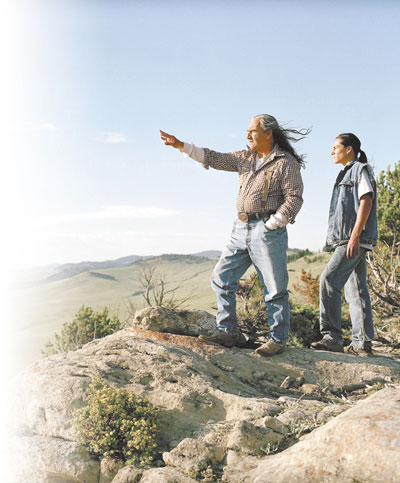
"They'll be wondering how the heck we did that." said T.J. Bews, who served as the Wrangler Coordinator for the film. Bews stated that they had used more buffalo ("and Native Americans") than he has ever worked with on an Indian film. "They wanted us to do things that I didn't think were humanly possible." said the wrangler on a promotional making-of-the film interview.
Beautiful cinematography and special effects fill the film with eye candy as several different tribal stories from all over the world unfurl on screen. Nicholas Brooks explains that for the painterly, dreamlike and ethereal effects of the Thunderbeings legend, they didn't use the usual blue screen and block in the landscape later. They shot the footage onsite, with the actors in the landscape, and shot the scenes using "stereo lenses...which gives the illusion of depth...actually capturing what the eye sees." This scene by itself makes "Dreamkeeper" worth watching.
That can be said about most all of the scenes and legends in the film.
The story is actually several stories within a story. It has all of the elements our old legends have. There are moral lessons, stories of unrequited love, tragedy, humor, courage, and redemption. Modern-day life of Indians living on a reservation is depicted with honesty and respect.
Everyone will be able to recognize family struggles, too, like an absent, alcoholic father, a mother who successfully holds the rest of the family together, a grandfather who sometimes has hard expectations, a young man full of potential, but angry at everyone in his life.
The story starts with an aging storyteller who wants his troubled gang-member grandson to take him to his last pow-wow, the All Nations ceremony in New Mexico. This is no easy task, since they are driving from the Pine Ridge Reservation in a 1966 pick-up truck (aka Many Miles With No Muffler). It doesn't help that stubborn Grandpa insists that they bring along his horse for the Giveaway.
Shane doesn't want to go; he has his own problems. But while he grapples with the "Dog Soldiers," his Native American gang, his grandpa annoys him by telling old stories. As he narrates, each story unfolds on screen. There are stories from the Lakota, the Kiowa, the Mohawk, and from the Pacific Northwest.
With a cast of over 80 important characters (not including extras), all but one are Native American.
Eddie Spears plays "Shane;" Genie Award-winning August Shcellenberg (Black Robe) plays "Grandpa;" and Shiela Tousey plays the role of "Janine," Shane's mom. Some of the actors are making their debut, some are familiar. All of them are believable. They seem familiar. They will remind you of uncles, cousins, elders in the community, and maybe, even, yourself.
One playful story is about Coyote and Iktomi traveling together and becoming hungry. With unusual lighting and stop-action filming, the old legend blurs into the twenty-first century as they skitter across a paved highway looking for food. We meet Iktomi's wife, who looks just as spiderish as her troublesome husband. John Trudell as Coyote and Gary Farmer as Iktomi are perfect for the roles, and act off of each other well.
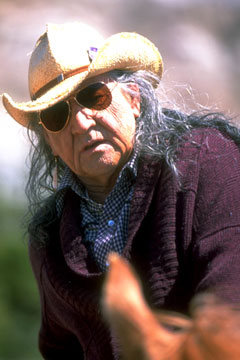
Delanna Studi, who plays a sincere and outspoken Kiowa woman, says that she is encouraging her nephew to learn his tribal language. She hopes that he and other children will be inspired to learn their language by this film.
Eddie Spears as Shane, does a convincing job as a frustrated young man who is confused about his life and future. He is glad that this film has been made, and feels that while it reflects the poverty, gang violence, and loss of traditions that young Indians face today, it also reflects the hope of the future and the relevance of our traditions to our lives today.
Nathaniel Arcand, "Broken Lance," reflects on his role and says that he has felt like his character felt, at one time in his own life. Yet he is playing a role out of the 1800's.
Writer John Fusco asked his adoptive Pawnee mother, Edna New Rider Weber, to serve as one of many Native American elder advisors on the film. She states that while watching the filming of a warrior scene, she thought of her own sons and grandsons who have and are serving in the armed forces. Sonny Richards, Lakota, contributed songs for scenes that called for authenticity.
"Dreamkeeper" is an entertaining as well as meaningful film, and will appeal to children, artists, and Native Americans of all ages. The stories come to life and are told with vibrance and quality.
From the Grand Forks Herald, 1/6/04:
DORREEN YELLOW BIRD: 'DreamKeepers' marks new era in films about Native Americans
I don't like and rarely watch two-part films on television because it means I have to be in place in front of the TV the next evening. I also don't like most films about Native Americans. I am squeamish about watching films where all Native people are portrayed as alcoholics who live in poverty. Nor do I appreciate portrayals of holy men that are taken straight from the imagination of writers who know little about medicine men or spiritual people.
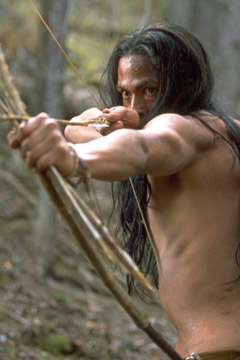
I watched the two-part "DreamKeepers" last week hoping it would beat the odds on all of those things. I wasn't disappointed. The film won the Best Film award at the 28th Annual American Indian Film Festival in San Francisco in November. It also was a winner in my mind.
The film is about young Shane Chasing Horse, a Pine Ridge Lakota Sioux (played by Eddie Spears) and his grandfather, old Pete Chasing Horse (played by August Schellenburg). Sounds too typical, doesn't it? But where the story diverts from the typical is in its setting and the craft with which the movie was made. Those become its great strengths.
The setting is Pine Ridge, S.D. The Native community in the film is typical but not awful. The movie doesn't deny there are gangs, poverty and alcoholism; but, unlike many Native American films, the movie doesn't make these the center of the story. They're background.
Shane is in trouble with what might be called the "Indian Mafia." He owes them money. His mother strongly suggests that he take his grandpa to the Gathering of Nations powwow in Albuquerque, N.M., where the elder is to tell stories. He is the "DreamKeeper."
The young man knows the "Mafia" is after him, so he reluctantly drives that long road in an old, beat-up '66 Ford pickup nicknamed Many Miles With No Muffler. During the trip, his grandfather fills his ear with stories as they chug along that southwestern highway.
The Indian Mafia does catch up with them at one point. The grandfather also takes Shane to see his estranged father, who is a reformed alcoholic. A relationship develops between the boy and his father.
The film is an "epic odyssey of a Lakota grandfather's final storytelling," says a press release.
One thing that's exceptional about this film is that it is filled with Native American actors. Years ago, it was routine to use actors such as Burt Lancaster or Victor Mature, heavily made-up and with black braided wigs, in roles as Native people. They spoke phrases such as, "Me, Indian." "Me want water." That always irritated me because those Native people in the 1800s probably used sign language rather than stilted, single-word phrases.

Today there is a long lineup of Native American actors, some nationally known -- Michael Horse, Elaine Miles, Gary Farmer, Russell Means, Graham Greene, John Trudell, Nathan Chasing Horse, Rodney Grant, Floyd (Red Crow) Westerman and others. They gave this film an authentic feel and seemed to know their ground.
In addition, the stories told by elder Chasing Horse and woven throughout the film were authentic. I knew some of them, as they were told by my grandmother.
The stories include the Lakota story of Eagle Boy's vision quest, the Akwesasne Mohawk story titled "Thunder Begins" and a Pawnee story about a woman and her son. The movie also featured coyote and iktomi (red spider) stories that were especially wonderful. I have seen few better portrayals of coyote than in that film.
The tales were identified by tribe and by some photographs by Edward Curtis; he was an early 1900s photographer of the West. I don't know if the film will be rerun, but it certainly is worth seeing. I hope that "DreamKeeper" is just the beginning of films of this kind and that they get even better.
Films such as this are a good way to break stereotypes and bring understanding in a painless way.
From the Los Angeles Times, 12/28/03:
COVER STORY
Legends Are Living On in 'Dreamkeeper'
Traditional Native American stories make for an involving miniseries that entertains as well as it enlightens.
By Jacqueline Cutler, Special to The Times
ABC's "Dreamkeeper" is that rarest of miniseries for which it is worth setting aside family viewing time.
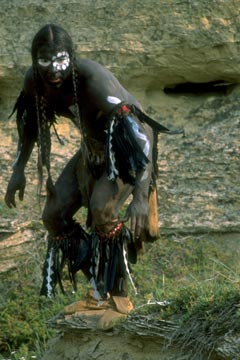
Parents need not dread mind-numbing treacle for themselves or racy content for their children. The Hallmark Entertainment epic that airs Sunday and Monday pulls off the tricky feat of entertaining while educating viewers about Native American legends. Indeed, even the Native American stars say they learned much, especially about tribes other than their own.
"What always bothers me about the general knowledge of Native Americans is that the American public assumes there is one or two tribes," says Delanna Studi, an actress of Cherokee, German and Irish descent who plays a Kiowa woman. "They are familiar with Sioux and Navajo. There are 547 federally recognized tribes.... Each tribe has its own language and culture and creation story. They weren't just doing the major tribes everyone has heard of. Most people thought these had gone extinct. It keeps their people and their stories alive."
Their stories and the way in which legends are passed through generations are the crux of the miniseries.
The ambitious story opens with Grandpa (August Schellenberg, "Black Robe") telling stories to children on the reservation. He wants to go to an All Nations ceremony but is not well enough to drive alone from South Dakota to New Mexico. His disaffected grandson Shane (Eddie Spears, "Geronimo"), is coerced into driving him. This road trip gives the movie its framework, for as they drive Grandpa tells Shane stories.
"It was the role of a lifetime, and I have been doing this for 40 years," Schellenberg says. "I knew a few people like him," he says of the aged storyteller. Schellenberg, who is Mohawk and Swiss, grew up in Montreal in a foster home. He learned some Lakota for the part and was thrilled when he realized the scope of this project.
"After the first day, I came home and said this man [director Steve Barron] is not making television, he is making a movie," Schellenberg says. "For an actor, that is such a treat nowadays. So many directors just wing it.... Everything was in the [Canadian] province of Alberta. It was wonderful. We had snow when we needed it and rain when we needed it. The spirits were with us."
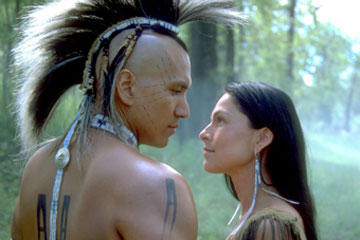
Spirits and spirituality are central to the legends. In the first, "Legend of Eagle Boy's Vision Quest," a young man fasts and meditates for days, seeking guidance. He learns that the goodness of the Earth, of people and of spirits must work together.
It took 2,500 Native Americans, from extras to advisors, to make the 10 stories come alive. Each story does, from 1,500 buffaloes stampeding across an Alberta plain to the special effects of "Legend of She Crosses the Water and the Thunder Spirit."
In this one, the powerful thunder spirit falls in love with a Mohawk woman working in a cornfield. He persuades her to come to his realm, but when she becomes pregnant, she returns to her people. The only caveat is that no one must ever strike their son, and when his mortal grandmother slaps the rambunctious boy, he is taken to the sky.
No narrator drills in the moral of each story, though lessons abound.
Shot over four months, primarily in Canada, each legend has its own actors and individual look. The movie employed 15 Native American and Native Canadian advisors to ensure the authenticity of every detail.
In one tale, "Legend of Quillwork Girl and Her Seven Star Brothers," even the advisor was shocked to see rare Cheyenne leopard dogs. When men were hanging buffalo meat in the background, the advisor said women would have done that chore, so Barron changed the scene.
"Dreamkeeper" tackles tough subjects, such as that of a white boy reared by Kiowas in "Legend of Tehan, the Red-Haired, White Kiowa." He is not fully accepted by either group, but his Kiowa sister, Talks A Lot (Studi), stands by him.
Not all of the legends are serious. "Legend of Coyote and Iktome" and "Legend of Coyote and Iktome and Iktome's Wife" are slapstick.
These legends are Spears' favorites. Playing a troubled teen who owes money to gangbangers and listens to rap was great, he says. "I kind of relate to him, growing up on 'the res,' " says Spears, a Lakota who spent his first six years on a reservation before moving to Pierre, S.D.
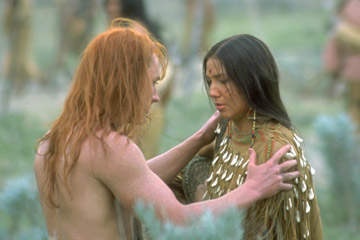
The actors rave about the miniseries' accuracy, which offers the sort of detailed history that is usually the purview of drier documentaries. Given that "Dreamkeeper" is told as a series of stories, viewers will probably stick with it, and by doing so learn more about indigenous people.
Studi, a niece of actor Wes Studi, says she hopes viewers glean "the fact that Native Americans are a living people, a modern people, and we have such complex and interesting stories. We are not all the same."
Studi, comic Alan Sues' personal assistant in Los Angeles, says: "I am hoping it will develop a new respect for us. And my main hope for the native viewers is I want people like my father, who was sent to boarding school to have the Indian beaten out him, I want them to be proud again. I want the youth to learn as much as possible.
"A lot of our elders are passing, and when they pass, people like myself and like my little sister will need to keep the stories alive. I am hoping that the native youth will embrace this, so people will always know we are still here."
Jacqueline Cutler writes for Tribune Media Services.
From Indian Country Today:
Must see TV moves to ABC with ‘Dreamkeeper'
A Review
Posted: December 29, 2003 -- 9:41am EST
by: James May / Indian Country Today
SACRAMENTO, Calif. -- In the Indian world, the past, present and future all exist as one. Unlike the European and Middle Eastern worldview, the spiritual and physical world occupy the same space. Beyond being just a stunning achievement, the ABC television miniseries "Dreamkeeper" is also a success in incorporating an Indian worldview.
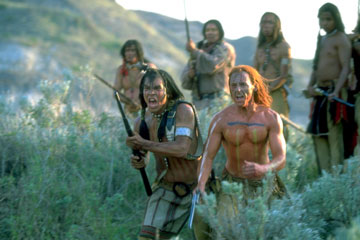
After nearly sweeping the American Indian Film Festival in San Francisco, in which a truncated version of the three and a half hour film was shown, the full version will be broadcast over two nights on Dec. 28 and 29, and is nothing short of an epic.
The miniseries will be presented as a Hallmark Hall of Fame special and though it does have some of the overly-sentimental trappings those presentations are known for, it also pulls very few punches and is not afraid to be iconoclastic at times.
The basic plot of "Dreamkeeper" is really simple, Pine Ridge teenager Shane Chasing Horse, played by Eddie Spears, is asked by his mother to take his 87-year-old grandfather Pete, played by August Schellenberg, to the All Nations Pow Wow in Albuquerque, N.M.
Shane only reluctantly agrees after he gets in trouble with a reservation gang for owing them money. It gets worse because Shane also hawks one of the gang member's boom boxes to buy his girlfriend a ring.
After being told by the gang that he could expect to find himself "in the badlands," if he did not pay back the money and return the boom box, Shane decides it might not be such a bad idea to take his grandfather on the journey from South Dakota to New Mexico with the gang members in pursuit.
Being that Pete is a storyteller, he wants to make sure that Shane is on the "red road" before he dies and begins to seamlessly weave in stories and legends from various tribal mythologies.
The myth interludes are really what set this film apart. Though the primary characters are supposed to be Pine Ridge Lakota Sioux, the legends are from various tribes at various points over the past 1,000 years. The special effects were created in four different locations around the world, including Paris and San Francisco, and finally seem to have reached a level of sophistication that is worthy of making tribal legends come to life.
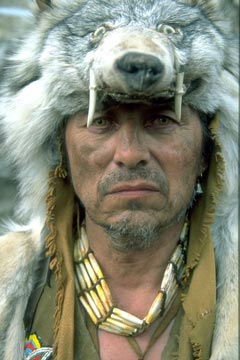
Though myths from other tribes are woven in, most are stand alone pieces in that the legend is told in a singular segment. However, it is a Lakota legend about the vision quest of Eagle Boy that resurfaces several times throughout the story and tells a concurrent story that parallels Shane's own difficult journey to find his Indian identity.
Though there are some tragic sequences in "Dreamkeeper", the tone is fairly light. There are some absolutely hysterical sequences in both the present and in the myths. The Lakota legend of the Bluebird Woman has an especially funny sequence, as does the later Pawnee legend of the Dun Horse.
Though not American Indian, nor even American, British director Steve Barron ("Coneheads", "Arabian Nights") and of course writer John Fusco ("Young Guns") must be credited for being unafraid to add the dimension of humor to the legends and for their delicate handling of that not so easy task.
In this case, veteran actors Gary Farmer and John Trudell stand out in a funny little series of vignettes about Coyote and Spider, the trickster figures in the folklore of various western tribes.
In one case, the Kiowa legend of Tehan, a comic character named Talks A Lot, played by Delanna Studi becomes the heroic figure. It should be noted that though Studi probably has less than a total of 10 minutes of screen time, her role was memorable enough to land her the Best Supporting Actress Award at this year's American Indian Film Festival.
In addition to Studi, Schellenberg and Spears also collected Best Actor and Supporting Actor awards for their turns as members of the Chasing Horse clan.
The myth sequences also give an air of authenticity. At the beginning of each myth sequence, a specific year, or in a few cases a specific century and location are given. However, in a shrewd move, the locations given are their physical location and not their modern state names to emphasize the Indian point of view.
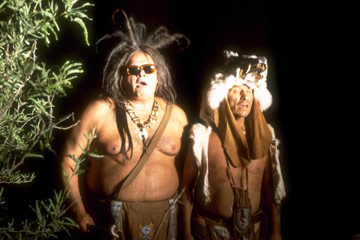
It is also refreshing to see the Indian point of view told by Indians themselves. Though Dustin Hoffman is a great actor and "Little Big Man" is a very good movie, it's nice to finally see a mainstream film where Indians are the primary characters. It is also equally heartening to see that the success of "Smoke Signals" pioneered the simple notion of having Indian actors play Indian roles.
"Dreamkeeper" also avoids falling back onto the cheap and easy cliché of the whites who are interested in Indian culture and gently tackles the difficult issue of Indian prejudice. In one scene, after being approached by a young, white hipster type who claims a distant kinship to the Kiowas, Pete scolds his grandson for being dismissive and referring to the young white as a "wannabe."
"Yeah, he's a wannabe alright," counters Pete, "he wannabe connected."
Pete then uses this as a prelude to the Kiowa legend of Tehan, a white who was adopted into their tribe and had to overcome their prejudice to prove he was a Kiowa.
This is not to say that they do not poke fun at the clumsy efforts of the well-meaning young white man in the present day, but Pete's story takes out the venom and the pointed criticism is transformed into gentle fun.
In this, "Dreamkeeper" is simultaneously more iconoclastic and effective in its criticism than Sherman Alexie's, the author of the short story on which "Smoke Signals" is based, over-the-top and quasi-bitter takes on the same subject. That kind of criticism was needed and fresh in the days when Seattle grunge ruled the charts, but now just sounds as cranky and out-of-date as that old Alice in Chains beginning to gather dust on the shelf.
The only places where "Dreamkeeper" fails is that it often can not hold up all the disparate stands that it weaves and some crucial parts are resolved too quickly. Without giving too much away, the issue of the gang members in pursuit, though woven well with the myth, is settled very suddenly and in corny Hollywood fashion.
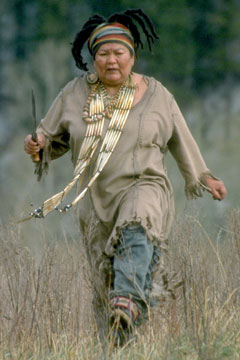
Similarly, once again, without giving too much away, Shane's personal problems are resolved all too quickly and though there is plenty of good reason through the telling of the myths for a slow and gradual change, Shane's ultimate redemption seems too jarring and sudden.
These problems are minor and in general the myth sequences alone are worth watching and are enhanced by fine performances by not just the leads but a very talented supporting cast that features many veterans including the very likable Tantoo Cardinal. Best Actor Schellenberg's performance can only be described as first class and somewhere in the spirit world Chief Dan George is looking on with a smile.
And from the Native American Times:
COMMENTARY: Dreamkeepers is a tribute to Native legends
Hallmark and ABC deserve high marks for producing high quality mini-series
TULSA OK
Louis Gray 12/27/2003
There are some who are critical of the Hallmark/ABC production "Dreamkeepers" because some eastcoast reviewers fail to understand how well the makers of this mini-series did in making such a great film.
Solid acting, great special effects and a well-written script are just part of the reason the show works. Some of Indian country's most talented and beautiful cast has been assembled for this production.
To ensure more films are made in the same respectful manner, Indian viewers need to take an active role in letting the network know they did a good job. Call the local affiliate and let them know you watched and you liked what you saw.
Call Hallmark Entertainment and let them know you appreciate their commitment to telling a story from a Native American perspective.
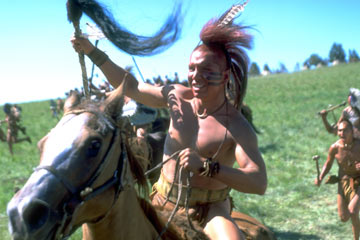
Call ABC and let them know you watched and you liked what you saw.
Some suggested the mini-series was hidden because the network had little faith in the mini-series.
Indian people can make a difference here. Call, write, fax and email the powers that be and tell them what you think. They do want to know.
Our Indian people don't see themselves on television and film in positive or historically correct ways. Accordingly, young Indian people don't have anyone to look up to the ways other cultures do. Indian people don't have a television show, or another Smoke Signals on the horizon. Unless you call, or write those in power about your feelings.
Indian people can complain about the lack of Indian role models or we can all do something about it.
The critics strike back
Perhaps because they were less famil-iar with Native history and culture, or less awed by it, non-Native critics were less wowed by Dreamkeeper. Some of their opinions:
From the Los Angeles Times, 12/26/03:
TELEVISION REVIEW
Stories come to life
Although it's beautiful to look at, ABC's 'Dreamkeeper' can't slip the bonds of formula.
By Robert Lloyd, Times Staff Writer
Given that television is usually content to reflect and flatter only its fattest demographics, ABC is to be congratulated for putting up the money, and no little bit of it, to make "Dreamkeeper," a sprawling, four-hour cavalcade of Native American legends-come-to-life that airs Sunday and Monday nights. Produced by the team of Robert Halmi Sr. and Jr., who have made a career of converting folk tales and literary classics -- from Dostoevsky to Dickens to "Dinotopia," from "The Odyssey" to Orwell -- into high-gloss television events, it bears all the hallmarks of their house style, being sympathetic, sincere, scrupulously researched and sumptuously mounted, but also sentimental, simplistic and overlong.
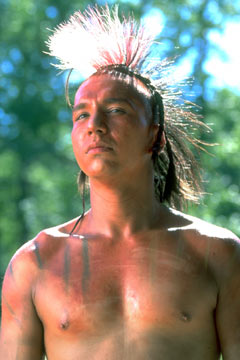
Old Pete Chasing Horse (August Schellenberg, of "Black Robe" and the "Free Willy" franchise), is an aged Sioux storyteller living on South Dakota's Pine Ridge Reservation. He is being driven to a big pow-wow in Albuquerque by his reluctant and troubled teenage grandson, Shane (Eddie Spears), a classic at-risk type in a "Custer Died for Your Sins" T-shirt. (They are doing it all off the interstate, apparently, the way people in movies do.) Foxy grandpa has ulterior motives, and as they travel along -- in an old truck he calls Many-Miles-With-No-Muffler -- he tells ancient tales in a pointed attempt to get his grandson back on "the red road."
"Dreamkeeper" starts out well, in scenes rich with telling domestic detail. Writer John Fusco ("Crossroads," "Young Guns") who lived for several years at Pine Ridge, researching the film "Thunderheart," was given his own Indian name and speaks Lakota, and obviously knows, and loves, his subject. But if his characters are not the stereotypes of westerns past -- gangs and alcohol and tribal casinos and other realities of present-day life on "the rez" are at least alluded to -- they are nevertheless cut from cardboard. Brightly painted cardboard, to be sure, bent into a semblance of three dimensions, and given decent life by the actors, but subject to a script that follows the industrial logic of screenwriting -- which is to say, it gives viewers what it is assumed viewers want.
Only someone watching television for the first time will not be able to see from the earliest moments exactly where grandfather and grandson are headed. The ease with which conflicts are finally resolved is almost distressing, and not a little ironic in a film whose subject is the power of storytelling. "A people without stories," says Old Pete, reaching into his bottomless bag of aphorisms, "is like wind in the buffalo grass." Got that?
The interpolated native legends themselves are nevertheless splendidly rendered. Drawn from several Indian nations, each has its own visual scheme and palette -- director Steve Barron, who also helmed the Halmis' "Merlin" and "Arabian Nights," got his start in music videos, and it shows, sometimes a little too much. The stories encompass the magical, the historical, the farcical and the moral: Have pride but don't be proud; put the community before yourself; be careful what you wish for; and if a spirit or any other magical being tells you to do something, follow the instructions to the letter.
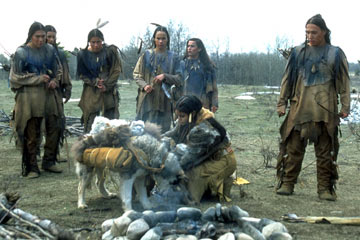
Especially well done are the tale of how Quillwork Girl and her seven adopted brothers became the Big Dipper; the cross-planar romance of Thunder Spirit and She-Crosses-the-Water; and a couple of comic stories involving trickster Coyote and Iktome the spider, played by John Trudell and Gary Farmer ("Adaptation").
Spread in installments across the breadth of the film is the story of Eagle Boy and his misguided vision quest, and though the intercutting seems to suggest a parallel between him and Shane, that doesn't quite pan out. What it does suggest is that a good cliffhanger knows no cultural bounds.
As in many other Halmi productions, special effects are key -- we get a giant snake monster, witches and ghosts, a mountain that turns into a bear, a flock of ravens forming a spirit's face, and the watery domain of the Thunder Spirit -- and here they have the appropriate quality of blurring the lines between the other world and this one.
But much care has also been lavished on the unspecial effects, from tepees to buckskins to face paint. Most impressive is the way the camera captures the landscape and what fills it; shot on location from Arizona to Canada (by Jon Joffin), "Dreamkeeper" is beautiful to look at, and it is in this that it best expresses the invaluable aboriginal notion that all things -- men and women, horses and buffalo, rock and tree and water -- are alive and equal and worthy of respect.
From David Bianculli in the New York Daily News, 12/26/03:
Nightmare for ABC
Hackneyed 'Dream' is no 'keeper'
Cliches rule in ABC's ultra-PC Native American miniseries 'Dreamkeeper.'
ABC is burying its four-hour "Dreamkeeper" miniseries in the dismal TV wasteland between Christmas and New Year's Day because the network has no faith in the drama's ability to lure and sustain an audience.
The scheduling is entirely justified.
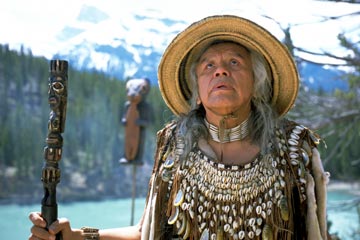
But the question is: If ABC can be smart enough to burning off "Dreamkeeper" as an end-of-year tax toss, why was it dumb enough to approve the miniseries in the first place?
You could ask the same question of CBS regarding "The Reagans." Most of us did.
In this case, ABC believed too strongly in the abilities of executive producers Robert Halmi Sr. and Robert Halmi Jr., whose credits include "The Odyssey" and "Merlin," to deliver one entertaining long-form drama after another.
The problem is the Halmis miss as often as they hit. For every home run, like "Gulliver's Travels," there are mighty strikeouts, like "The Magical Legend of the Leprechauns" and "Noah's Ark."
"Dreamkeeper" takes legends from Native American culture and dilutes them with shoddy special effects, subpar acting and no sense of excitement or urgency.
Writer John Fusco and former video director Steve Barron conspire to infuse each story and flashback with its own special look. But most of the stories are acted and recited as if by rote -- like a little kid reciting the Pledge of Allegiance without any understanding of what the words mean.
The main characters are a 100-year-old tribal storyteller (August Schellenberg) and his rebellious teen grandson, Shane Chasing Horse (Eddie Spears). Shane's mother (Sheila Tousey) orders him to accompany his grandfather to an All Nations powwow.
Along the way, the elder spins old stories as the trip takes on a meaning and message of its own.
There are a couple of good performances here -- from the memorable but underused Kimberly Norris Guerrero as the beautiful apparition and Casey Camp-Horinek as the cloud-walking Sky Woman.
"Dreamkeeper" feels like a script that was politically corrected to death. It's so reverent, it seems frighteningly passionless.
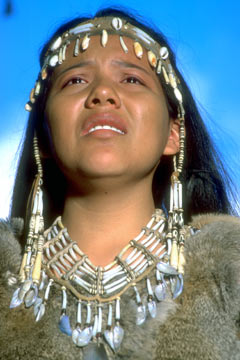
"Sometimes the stories come," Grandpa says at the start, "sometimes they go."
This one can go.
From the Boston Globe, 12/27/03:
TELEVISION REVIEW
Nightmarish excess ruins potential of `Dreamkeeper'
By Matthew Gilbert, Globe Staff, 12/27/2003
What happens when you take an intimate tale about a Lakota boy, his 87-year-old grandfather, and the healing power of Native American storytelling and drown it in big-budget, eye-popping, television-rattling special effects?
"Dreamkeeper" happens, and it's a big disappointment. This ABC miniseries could have been a sharp two-hour journey into Native American lore and the importance of family ties. Instead, in the hands of executive producers Robert Halmi Sr. and Robert Halmi Jr., whose TV events have ranged from the grand ("Merlin") to the grueling ("Noah's Ark"), it's a bloated, four-hour example of misspent energy and lost potential. Call it Digital Baroque, and call it very annoying. That's why ABC is burying the miniseries, which airs tomorrow and Monday nights at 9, in the post-Christmas programming void. Even the network appears to realize that "Dreamkeeper" is neither a dream nor a keeper.
The present-tense drama finds a troubled young man named Shane (Eddie Spears) driving his storytelling grandfather, Old Pete Chasing Horse (August Schellenberg), from their South Dakota reservation to the All Nations Powwow in New Mexico. As Grandpa shares Lakota myths with Shane along the way, the miniseries presents these tribal legends to us in hallucinogenic and oh-so-magical segments, reducing all their richly symbolic figures to literal images. Indeed, the majority of the action in the miniseries takes place in these fragments, which are set in different time periods and rely on a deluge of trippy editing techniques. There is, of course, a giant faux-Spielbergian snake whose slithering evokes about as much terror as a video-game villain.
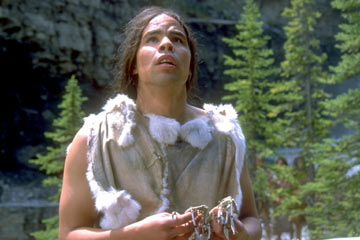
Amid all this hoo-ha, the central, unifying drama of Shane and his grandfather gets lost, at least until the final hour. Alas, few viewers will probably make it that far.
The ambition of "Dreamkeeper" is conventional but worthy. It tries to illustrate the value and importance of the myths we invent and how they serve to hold cultures together and empower individuals. There's a lot at stake in whether a Lakota youth will open up to his grandfather's stories. But by presenting these stories with mind-numbing excess, the miniseries defeats its own message. Perhaps with a few million dollars less, the filmmakers might have done "Dreamkeeper" justice.
(c) Copyright 2003 Globe Newspaper
Rob's comment
My views fall somewhere in the middle. I admired Dreamkeeper for the same reasons the Natives did—especially for its stereotype-busting ways. But several problems kept me from judging it a superior work of art. Among them were the preponderance of Plains Indian stories, the sometimes hamfisted messages, and the too-pat resolution of the conflicts.
Specfically:
So what's the moral here: that surrendering is the way to succeed? How exactly does this apply to Shane? Is the message that Shane is a failure but should keep trying anyway, because he may get lucky?
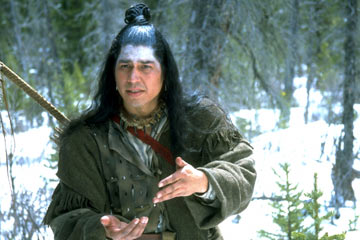
On the other hand, the story of Tehan, in which a white boy adopted into the Kiowa tribe proves his worth, was painfully applicable to the white boy Shane and his the grandfather picked up. The same actor with the same annoying traits played the "real" and legendary white boys. The point was as subtle as a sledgehammer: We're all the same under the skin.
Ideally, the stories all would've been subtly relevant to the real-life drama—with the emphasis on subtly.
Even more conveniently, the hoods went off with a vanful of attractive young women who just happened to stop by. So the biggest threat of part one vanished in part two...poof!
As Shane and his grandfather traveled the backroads—not the freeways, of course—I found the anonymous landscape irritating. As far as I can tell, they didn't pass anything recognizable—such as the Rocky Mountains—or name wherever they were. Would it have hurt the production to say they were passing through Nebraska or Colorado or wherever? To show a few roadsigns establishing their approximate location?
Are we supposed to believe he was so hungry he couldn't last another minute? And that they hadn't passed a single outpost of civilization—a home or ranch—in their trek cross-country? Even on horseback, wouldn't you follow the roads to avoid unexpected obstacles such as fences? Isn't wandering in the wilderness without food or water an obvious mistake?
The scene was inserted for comic relief, I guess, but instead it played as foolish nonsense.
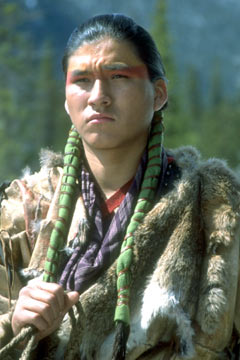
In short, it was all much too perfunctory.
The ending dissipated the drama that came earlier. In fact, there wasn't enough drama. The gang threat was muted and hard to take seriously...and other than that, there was only Shane acting grumpily. The story could've used another couple of subplots to create some suspense.
An award-winner
At the 12th annual First Americans in the Arts awards ceremony, held March 20 in Los Angeles, Dreamkeeper was the big winner. Eddie Spears (Shane), Delanna Studi (Talks a Lot), and Teneil Whiskey Jack (Quillwork Girl) all earned awards for their acting. Hallmark Entertainment and ABC received Trustee Awards for making and airing the mini-series.
As for me, I give Dreamkeeper a 7.5 of 10. Good but not great, in other words.
More on Dreamkeeper
Scene from Dreamkeeper
Related links
Dreamkeeper on the Net
TV shows featuring Indians
The best Indian movies
Readers respond
"Dreamkeeper was really good...and you know...I don't care what non Indians think about the movie!"
"Maybe it takes being all/part Native to appreciate 'Dreamkeeper.'"
|
. . . |

|
All material © copyright its original owners, except where noted.
Original text and pictures © copyright 2007 by Robert Schmidt.
Copyrighted material is posted under the Fair Use provision of the Copyright Act,
which allows copying for nonprofit educational uses including criticism and commentary.
Comments sent to the publisher become the property of Blue Corn Comics
and may be used in other postings without permission.